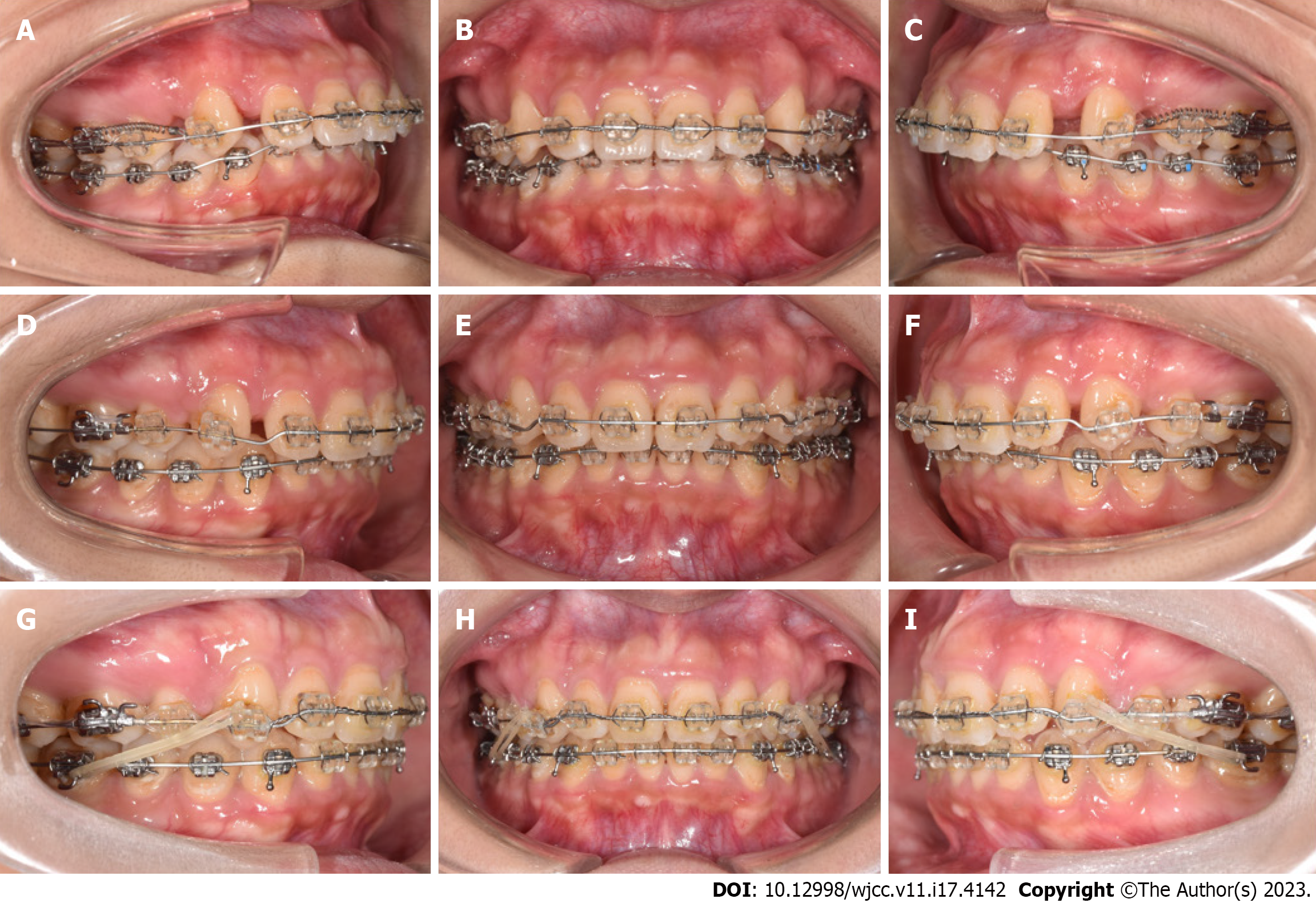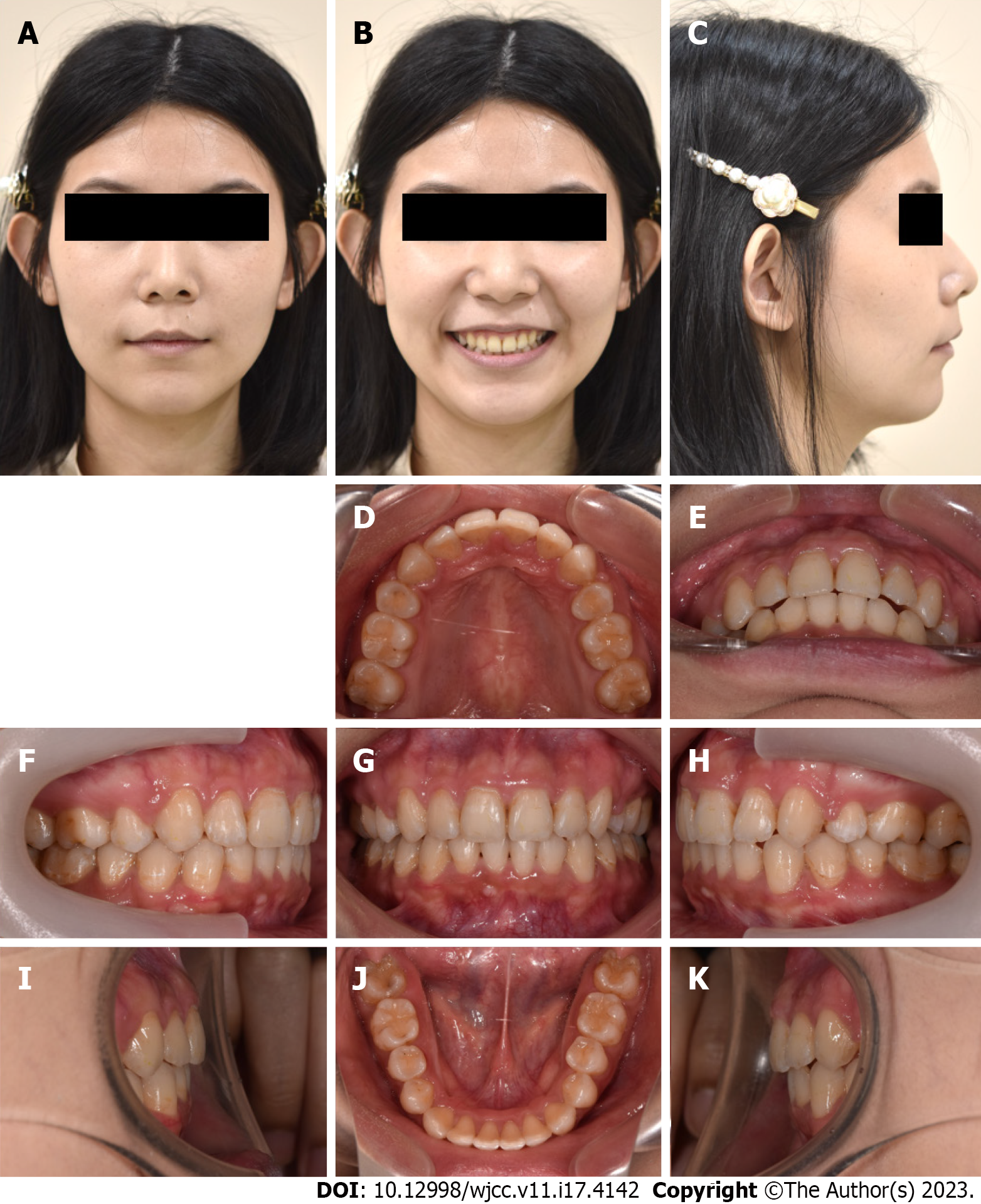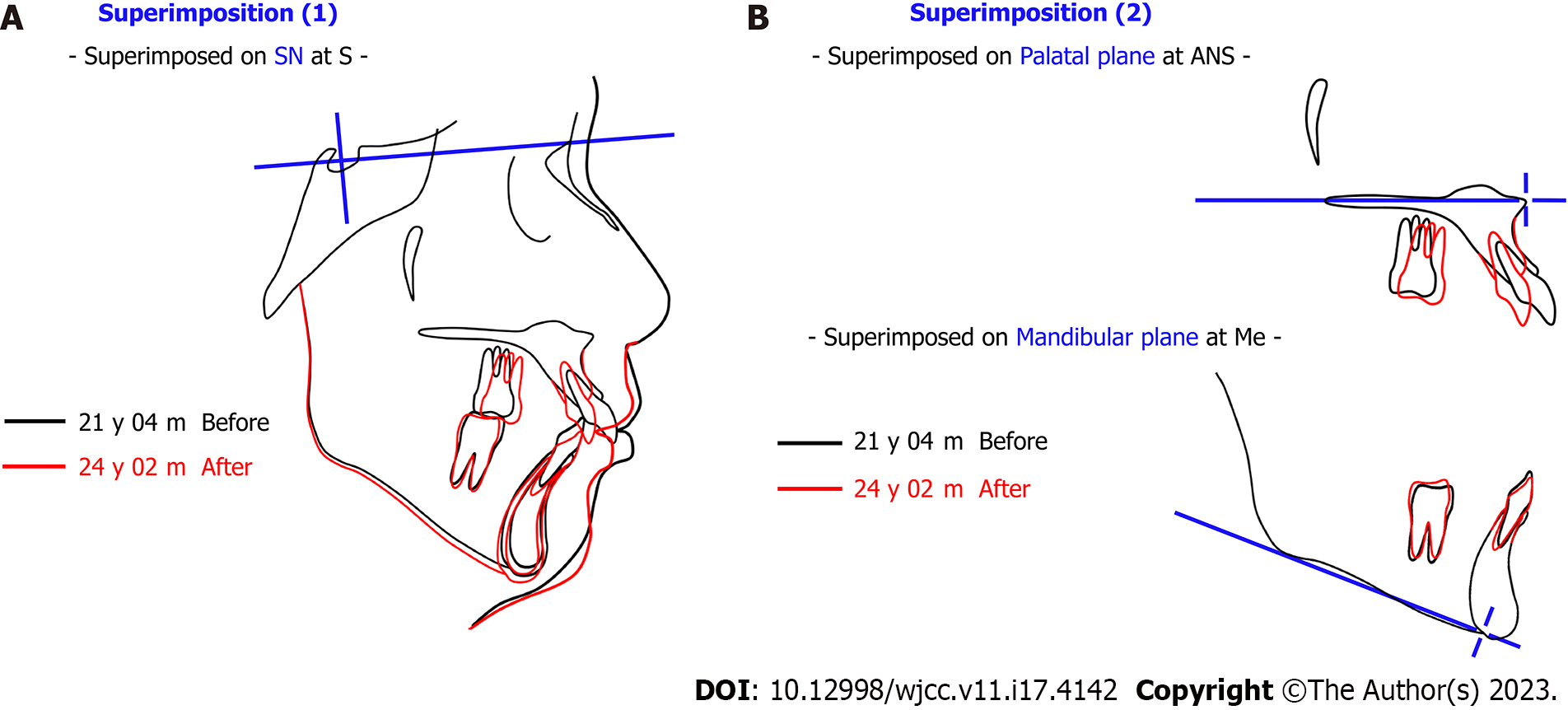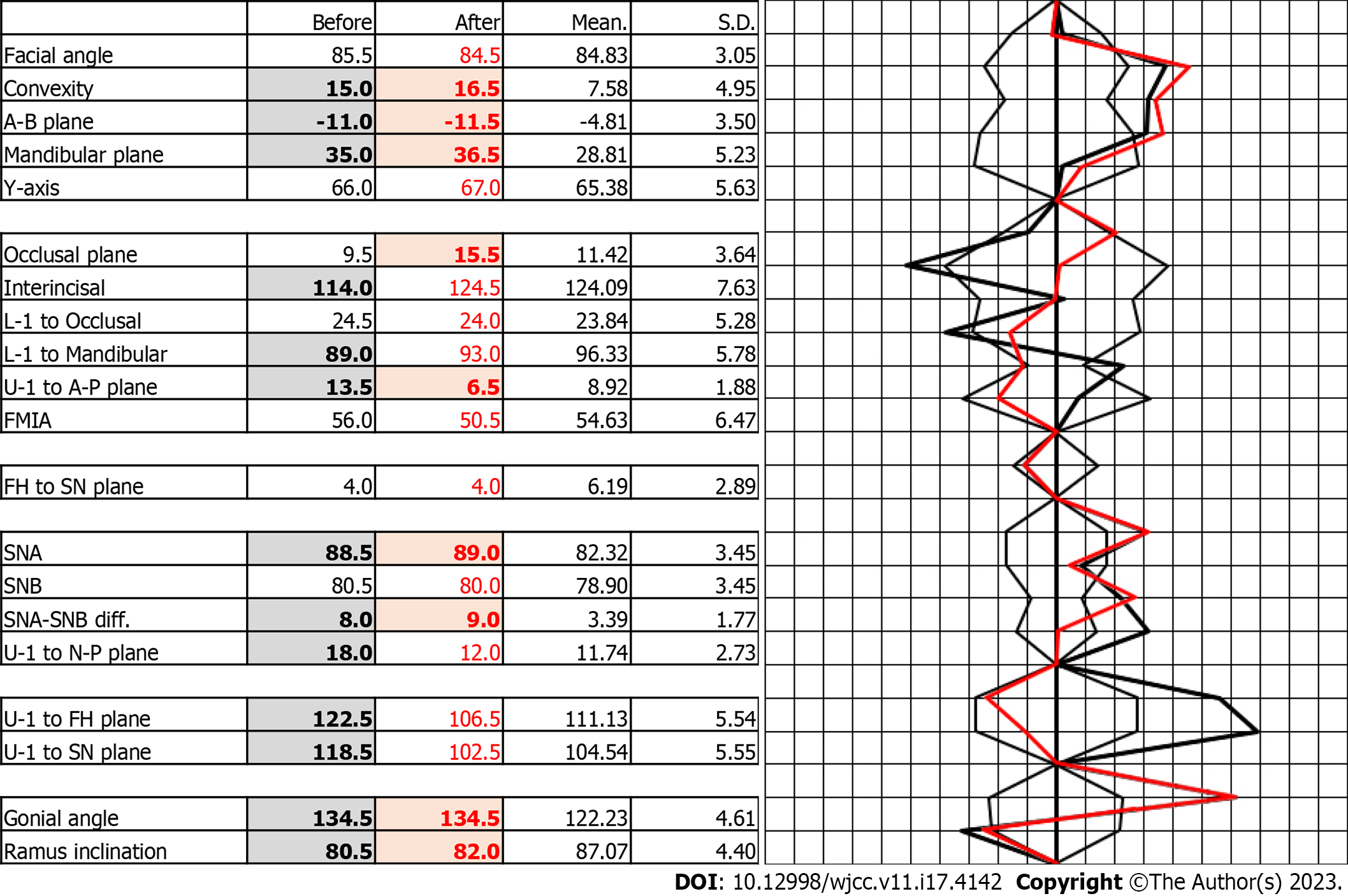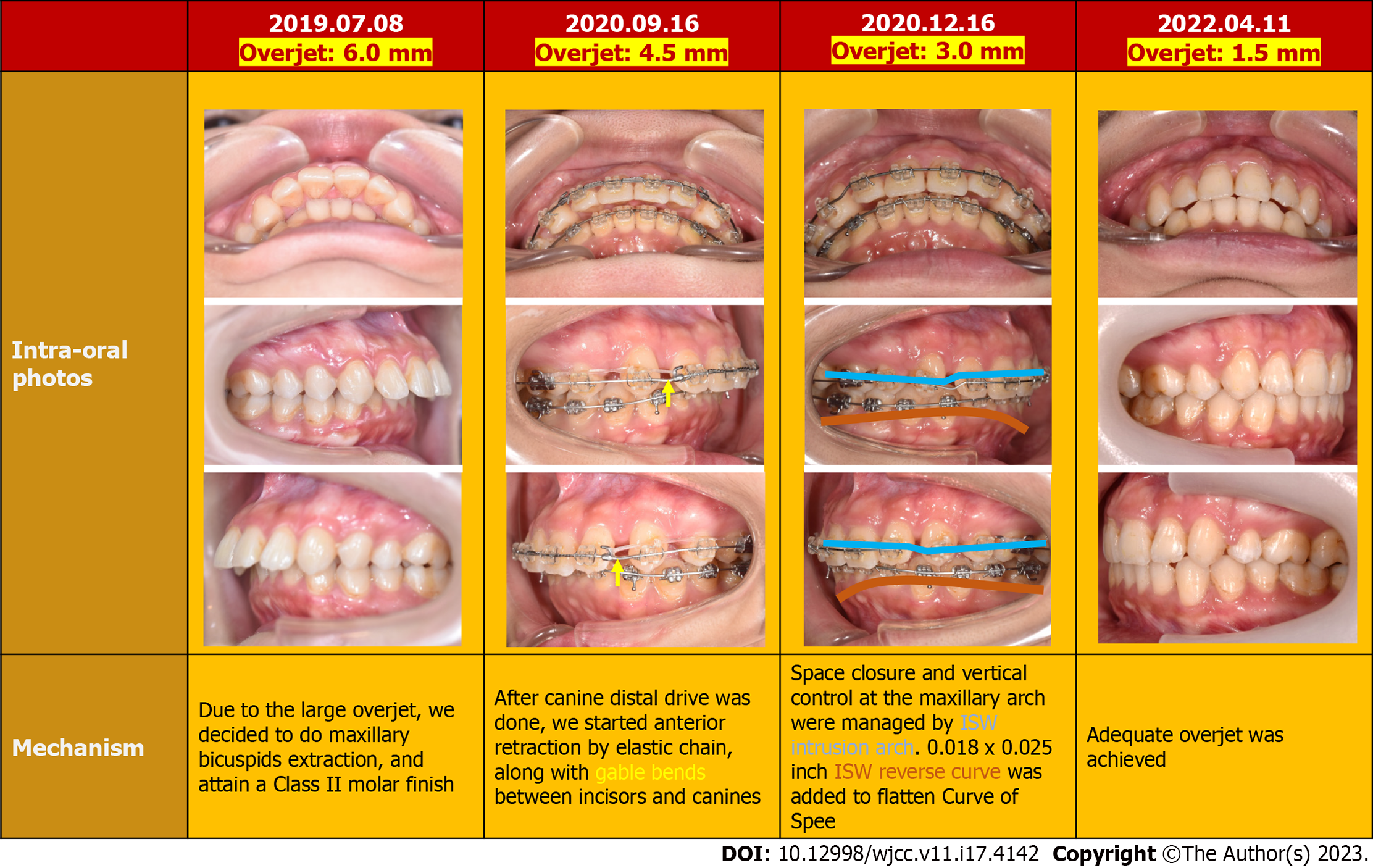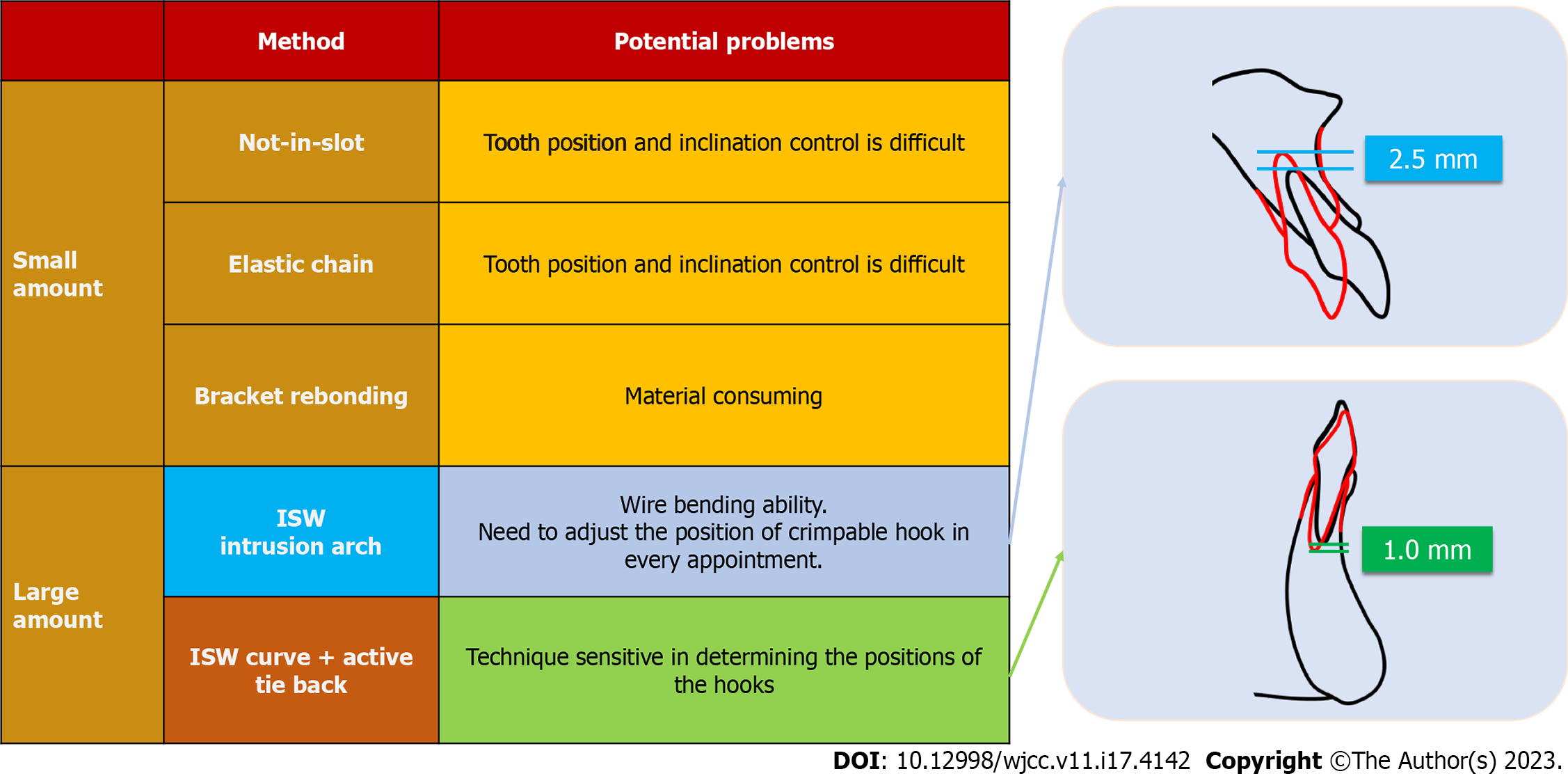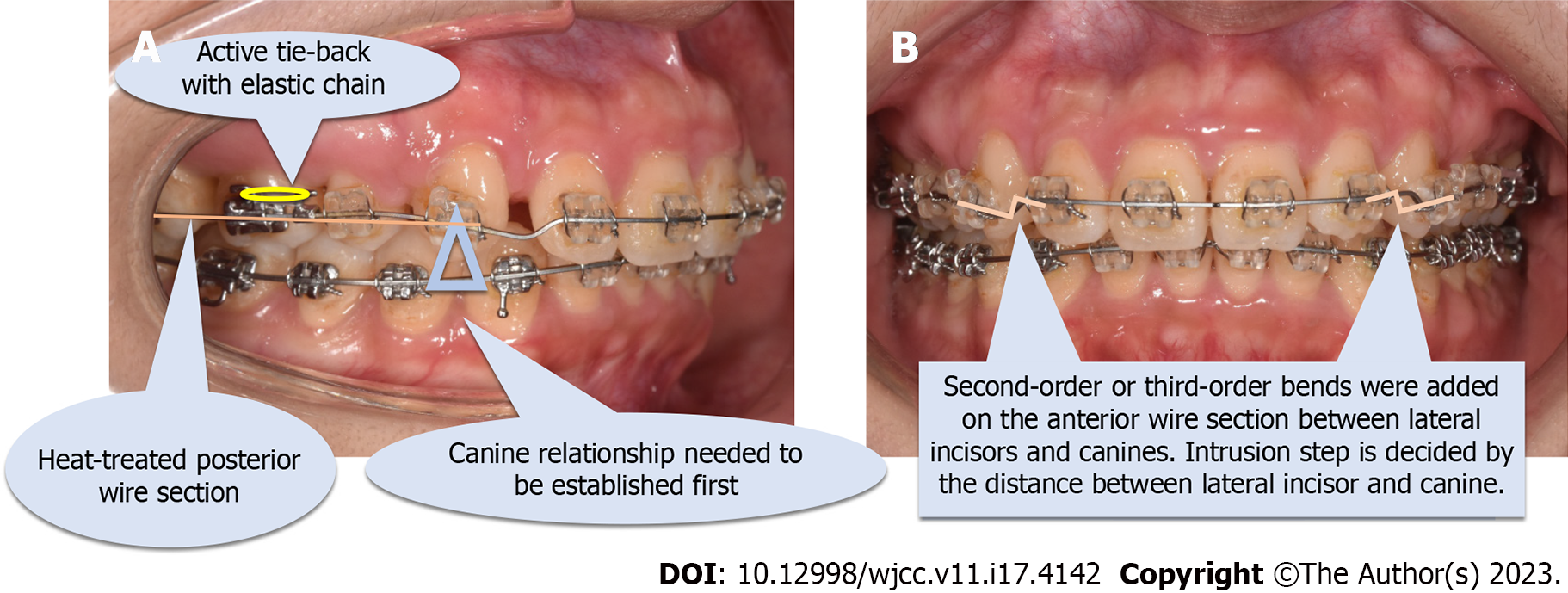Published online Jun 16, 2023. doi: 10.12998/wjcc.v11.i17.4142
Peer-review started: March 22, 2023
First decision: April 11, 2023
Revised: April 23, 2023
Accepted: May 6, 2023
Article in press: May 6, 2023
Published online: June 16, 2023
Processing time: 81 Days and 20.5 Hours
Treatment for deep overbite cases can be difficult. This case report presents some techniques with improved super-elastic Ti–Ni alloy wire (ISW) for deep overbite correction.
A 21-year-old woman had a chief complaint of flaring maxillary teeth. Ortho
The use of the ISW technique in a case of skeletal class II malocclusion with deep overbite achieved a desirable result, and the patient was satisfied with the treatment outcome.
Core Tip: Treatment for deep overbite cases is always challenging. In this skeletal Class II malocclusion with deep overbite case, we applied improved super-elastic Ti-Ni alloy wire intrusion arch to achieve ideal overjet, and the improvement in appearance and dentition alignment was noticeable.
- Citation: Yang CY, Lin CC, Wang IJ, Chen YH, Yu JH. Improved super-elastic Ti–Ni alloy wire intrusion arch for skeletal class II malocclusion combined with deep overbite: A case report. World J Clin Cases 2023; 11(17): 4142-4151
- URL: https://www.wjgnet.com/2307-8960/full/v11/i17/4142.htm
- DOI: https://dx.doi.org/10.12998/wjcc.v11.i17.4142
In orthodontic treatment, malocclusion means misalignment of teeth or incorrect relationship between the teeth and jaws. In Angle class II, division 1 malocclusion, the upper teeth are more prominent than normal, and patients usually complained of buck teeth. A 21-year-old woman with a chief complaint of flaring maxillary teeth sought orthodontic evaluation. Clinical examination revealed a skeletal class II malocclusion and a convex profile appearance. A deep overbite with palatal impingement and a large overjet were also noted. The patient denied any family history of present illness.
Treatments for correcting a deep overbite include anterior tooth intrusion, posterior tooth extrusion, or their combination. In class II malocclusion with a steep mandibular plane, anterior tooth intrusion might be favorable[1]. In conventional treatment, a two-wire system or a temporary anchorage device (TADs) might be needed for tooth intrusion. However, wire bending in a two-wire system is technique-sensitive, and TADs have potential problems of soft tissue irritation and tooth root damage. For this case, we used Improved super-elastic Ti–Ni alloy wire (ISW, L & H Titan, Tomy International, Tokyo, Japan) as the main wire. ISW was developed by the Tokyo Medical and Dental University. ISW is endowed with three superior abilities: super-elasticity, shape memory, and damping capacity[2-4]. The wire can be engaged into crowding dentition and can provide early dental torque control with ease.
In this deep overbite case, TADs were not used. ISW intrusion arch for anterior tooth intrusion was used. After 34 mo of treatment, a desirable aesthetic outcome was achieved. The patient was pleased with the final treatment outcome.
The 21-year-old woman complained of flaring maxillary teeth.
The patient denied any present illness.
She had nasal obstruction in childhood.
The patient denied any family history of present illness.
Pretreatment facial photographs showed a convex profile and shallow mentolabial sulcus. In the frontal view, no chin deviation was observed. The maxillary midline was coincident with the facial midline, and the mandibular midline demonstrated a right deviation (Figure 1). On intraoral photographs, the mesio-buccal cusps of the maxillary first molars are ahead of the buccal grooves of the mandibular first molars, which represented bilateral Angle class II, division 1 malocclusion.
All data were within normal limit.
A panoramic film radiograph revealed missing maxillary and mandibular third molars. Initial lateral and anteroposterior cephalometric radiographs (Romexis 3.2.0., Helsinki, Finland) were taken in centric occlusion with closed lips (Figure 2). Cephalometric analysis demonstrated a skeletal class II malocclusion (ANB angle: 8.0°), high mandibular plane angle (Frankfort-mandibular plane angle: 35.0°), proclined upper incisors (U1 to the Frankfort horizontal plane angle: 122.5°), and retroclined lower incisors (L1 to mandibular angle: 89.0°) (Figure 3). On anteroposterior cephalometric radiographs, the mandibular midline deviated 1.5 mm to the right side from the mid-sagittal plane (Cg–ANS).
The patient was diagnosed with skeletal class II with a deep overbite, hyperdivergent facial pattern.
This patient has class II malocclusion and deep overbite. We aimed to achieve the ideal occlusion of the bilateral class I canine relationship, facilitate the angle class II molar relationship, and attain normal overbite and overjet. Our treatment objectives were to: (1) Relieve crowding; (2) retract the maxillary anterior teeth; (3) correct the deep overbite; and (4) achieve improved arch coordination and interdigitation.
The patient was offered two treatment options. The first option was maxillary bilateral first premolar extraction and maxillary anterior teeth retraction. Considering the presence of occlusal plane canting and a relatively retruded chin, two-jaw surgery was also suggested. The patient refused surgery and chose the nonsurgical treatment.
Before orthodontic treatment, the bilateral maxillary first premolars were extracted. Full-mouth DBS was performed with preadjusted edgewise metal brackets, Micro-arch, Roth type (Tomy Company, Tokyo, Japan). Initial leveling progressed over the bimaxillary arch with 0.016-inch × 0.022-inch ISW. A 100-gf Ti–Ni closed-coil spring was used for canine retraction (Figure 4A-C).
After the maxillary canines were retracted to the designated position, anterior retraction began. First, an elastic chain was used for anterior retraction, and to avoid the bowing effect, gable bends were placed between the lateral incisors and canines. The maxillary anterior teeth were then intruded using the ISW intrusion arch. A 0.018 × 0.025 ISW reverse curve was also provided to flatten the curve of Spee (Figure 4D-F). Class II intermaxillary elastics (IME) (medium, 3/16-inch size) was used for overjet and intercuspal interdigitation adjustment (Figure 4G-I). After 34 mo of active treatment, the full-mouth brackets were debonded. A circumferential retainer and Hawley retainer were provided for the maxillary arch and mandible, respectively.
In this case, bilateral maxillary bicuspids were extracted. Canine distalization was performed using a closed-coil spring. The deep overbite was corrected with the ISW curve and ISW intrusion arch (Figure 5). After the treatment, proclined upper and retroclined lower incisors were corrected (U1 to familial hypercholesterolemia plane angle: 122.5°→106.5°; L1 to mandibular plane angle: 89.0°→93.0°), and the profile was improved (upper lip to E-line: 3.0 mm→0 mm) (Figures 6-8).
A deep overbite is always challenging to treat. We used several materials to reduce the initial large overjet, including Ni–Ti closed-coil spring, elastic chain and gable bend, ISW intrusion arch, and IME (Figure 9). We also attempted to solve the deep overbite by anterior tooth intrusion. The key to successful intrusion is light continuous force directed toward the root apex of incisors[5]. The ISW maintains continuous light force regardless of changes in the oral temperature, and this characteristic can be favorable during tooth intrusion[2,6-8].
Anterior tooth intrusion in a continuous wire system can be performed in several ways, such as the use of a utility arch[9] or Connecticut intrusion arch[10]; however, premolars are bypassed. In premolar extraction cases, simultaneous tooth intrusion and close extraction space might be difficult. Figure 10 summarizes ways to achieve this procedure in the ISW system. For incisor intrusion without extraoral appliance or skeletal anchorage, the intrusion amount can be classified into small (< 2.0 mm) and large (2.0–5.0 mm). In this case, an ISW intrusion arch for the upper incisor intrusion and an ISW curve plus active tie back for the lower incisor intrusion were applied.
In the ISW intrusion arch, we used the direct electric resistance heat treatment method for the second-order bend[11] by applying a Ni–Ti Heat Bender (SOARER X, Tomy International, Tokyo, Japan). With the second-order bend between the lateral incisors and canine, the anterior teeth can be guided to the final site. To avoid the buccal flaring effect of the anterior teeth, we applied an active tie-back mesial to the first molars using a crimpable hook and elastic chain (Figure 11).
The anterior tooth inclination plays an important role in posttreatment stability[12]. According to Riedel, a large interincisal angle after is associated with deep overbite relapse[13]. By adjusting the torque of the maxillary anterior teeth, a normal interincisal angle can be achieved, establishing an appropriate and stable anterior stop[14].
In this case, the treatment was completed without the use of TADs, thus avoiding risks of soft tissue irritation and root injury. While miniscrews were placed in loose alveolar mucosa, soft tissue irritation, such as tissue overgrowth or ulceration, may occur[15]. Root injury is highly relevant to the insertion site, especially in the interradicular insertion sites[16,17]. To intrude anterior teeth, the insertion site is usually between the apexes of the upper central incisor, where the risk of root injury is higher and is more prompt to soft tissue irritation like the labial frenum. It also reduces problems that might derive from TADs. TADs may become loose, tip, and extrude under orthodontic load. Mobile TADs will not regain stability and must be removed and reinserted[18,19]. Besides, if the insertion was inappropriate and removal torque was given, failure, or even implant body fracture, may occur[20]. Generally, in the maxilla, the insertion torque of TADs is approximately 12.1 ± 3.1 N-cm, and the average removal torque is 15.8 ± 3.6 N-cm[21].
As limitation, this report analyzed one case; a case series is needed to estimate the mean intrusion amount by the ISW intrusion arch. Without TADs, the intrusion amount of utility arch was 2.95 ± 0.78 mm[22], which is close our results. Further quantitative analysis is necessary, like the relationship between second-order bends and intrusion in the ISW system.
In the treatment of class II malocclusion with a deep overbite, anterior tooth intrusion should be considered. The use of the ISW intrusion arch achieved a desirable result, and the patient was satisfied with the treatment outcome.
Provenance and peer review: Unsolicited article; Externally peer reviewed.
Peer-review model: Single blind
Specialty type: Dentistry, oral surgery and medicine
Country/Territory of origin: Taiwan
Peer-review report’s scientific quality classification
Grade A (Excellent): 0
Grade B (Very good): 0
Grade C (Good): C
Grade D (Fair): D
Grade E (Poor): 0
P-Reviewer: Cho SY, China; Scribante A, Italy S-Editor: Liu JH L-Editor: A P-Editor: Zhao S
| 1. | Burstone CR. Deep overbite correction by intrusion. Am J Orthod. 1977;72:1-22. [RCA] [PubMed] [DOI] [Full Text] [Cited by in Crossref: 244] [Cited by in RCA: 228] [Article Influence: 4.8] [Reference Citation Analysis (0)] |
| 2. | Miura F, Mogi M, Okamoto Y. New application of superelastic NiTi rectangular wire. J Clin Orthod. 1990;24:544-548. [PubMed] |
| 3. | Miura F, Mogi M, Ohura Y, Hamanaka H. The super-elastic property of the Japanese NiTi alloy wire for use in orthodontics. Am J Orthod Dentofacial Orthop. 1986;90:1-10. [RCA] [PubMed] [DOI] [Full Text] [Cited by in Crossref: 311] [Cited by in RCA: 243] [Article Influence: 6.2] [Reference Citation Analysis (0)] |
| 4. | Iramaneerat K, Hisano M, Soma K. Dynamic analysis for clarifying occlusal force transmission during orthodontic archwire application: difference between ISW and stainless steel wire. J Med Dent Sci. 2004;51:59-65. [PubMed] |
| 5. | Nanda R. Biomechanics in clinical orthodontics. 1st edition. Amsterdam: Elsevier Health Sciences, 2005. |
| 6. | Yoneyama T, Doi H, Hamanaka H, Okamoto Y, Mogi M, Miura F. Super-elasticity and thermal behavior of Ni-Ti alloy orthodontic arch wires. Dent Mater J. 1992;11:1-10. [RCA] [PubMed] [DOI] [Full Text] [Cited by in Crossref: 56] [Cited by in RCA: 38] [Article Influence: 1.2] [Reference Citation Analysis (0)] |
| 7. | Otsubo K. Development of the super-elastic Ti-Ni alloy wire appropriate to the oral environment. J Jpn Orthod Soc. 1994;53:641-650. [DOI] [Full Text] |
| 8. | Otsubo K. Changes in force level of Ti-Ni alloy wires in the experimental oral environment. J Jpn Orthod Soc. 1994;53:555-561. [DOI] [Full Text] |
| 9. | McNamara JA. Utility arches. J Clin Orthod. 1986;20:452-456. [PubMed] |
| 10. | Nanda R, Marzban R, Kuhlberg A. The Connecticut Intrusion Arch. J Clin Orthod. 1998;32:708-715. [PubMed] |
| 11. | Miura F, Mogi M, Ohura Y. Japanese NiTi alloy wire: use of the direct electric resistance heat treatment method. Eur J Orthod. 1988;10:187-191. [RCA] [PubMed] [DOI] [Full Text] [Cited by in Crossref: 12] [Cited by in RCA: 15] [Article Influence: 0.4] [Reference Citation Analysis (0)] |
| 12. | Burzin J, Nanda R. The stability of deep overbite correction. Philadelphia: W. B. Saunders, 1993: 61-79. |
| 13. | Riedel RA. A review of the retention problem. Angle Orthod. 1960;30:179-199. [PubMed] [DOI] [Full Text] |
| 14. | Dermaut LR, Pauw GD. Biomechanical aspects of Class II mechanics with special emphasis on deep bite correction as a part of the treatment goal. In: Nanda R, editor. Biomechanics in clinical orthodontics. Philadelphia: W. B. Saunders, 1997: 86-98. [DOI] [Full Text] |
| 15. | Miyawaki S, Koyama I, Inoue M, Mishima K, Sugahara T, Takano-Yamamoto T. Factors associated with the stability of titanium screws placed in the posterior region for orthodontic anchorage. Am J Orthod Dentofacial Orthop. 2003;124:373-378. [RCA] [PubMed] [DOI] [Full Text] [Cited by in Crossref: 578] [Cited by in RCA: 536] [Article Influence: 24.4] [Reference Citation Analysis (0)] |
| 16. | Giudice AL, Rustico L, Longo M, Oteri G, Papadopoulos MA, Nucera R. Complications reported with the use of orthodontic miniscrews: A systematic review. Korean J Orthod. 2021;51:199-216. [RCA] [PubMed] [DOI] [Full Text] [Full Text (PDF)] [Cited by in Crossref: 6] [Cited by in RCA: 33] [Article Influence: 8.3] [Reference Citation Analysis (0)] |
| 17. | Montasser MA, Scribante A. Root Injury During Interradicular Insertion is the most Common Complication Associated with Orthodontic Miniscrews. J Evid Based Dent Pract. 2022;22:101688. [RCA] [PubMed] [DOI] [Full Text] [Cited by in Crossref: 17] [Cited by in RCA: 10] [Article Influence: 3.3] [Reference Citation Analysis (0)] |
| 18. | Liou EJ, Pai BC, Lin JC. Do miniscrews remain stationary under orthodontic forces? Am J Orthod Dentofacial Orthop. 2004;126:42-47. [RCA] [PubMed] [DOI] [Full Text] [Cited by in Crossref: 297] [Cited by in RCA: 283] [Article Influence: 13.5] [Reference Citation Analysis (0)] |
| 19. | Xin Y, Wu Y, Chen C, Wang C, Zhao L. Miniscrews for orthodontic anchorage: analysis of risk factors correlated with the progressive susceptibility to failure. Am J Orthod Dentofacial Orthop. 2022;162:e192-e202. [RCA] [PubMed] [DOI] [Full Text] [Cited by in RCA: 11] [Reference Citation Analysis (0)] |
| 20. | Sfondrini MF, Gandini P, Alcozer R, Vallittu PK, Scribante A. Failure load and stress analysis of orthodontic miniscrews with different transmucosal collar diameter. J Mech Behav Biomed Mater. 2018;87:132-137. [RCA] [PubMed] [DOI] [Full Text] [Cited by in Crossref: 50] [Cited by in RCA: 41] [Article Influence: 5.9] [Reference Citation Analysis (0)] |
| 21. | Suzuki M, Deguchi T, Watanabe H, Seiryu M, Iikubo M, Sasano T, Fujiyama K, Takano-Yamamoto T. Evaluation of optimal length and insertion torque for miniscrews. Am J Orthod Dentofacial Orthop. 2013;144:251-259. [RCA] [PubMed] [DOI] [Full Text] [Cited by in Crossref: 49] [Cited by in RCA: 48] [Article Influence: 4.0] [Reference Citation Analysis (0)] |
| 22. | Ma D, Wang XX, Jin SM, Dong R, Liu WX, Li J, Zhang J. [Comparison of two treatment method for maxillary incisors intrusion]. Shanghai Kou Qiang Yi Xue. 2013;22:206-209. [PubMed] |












